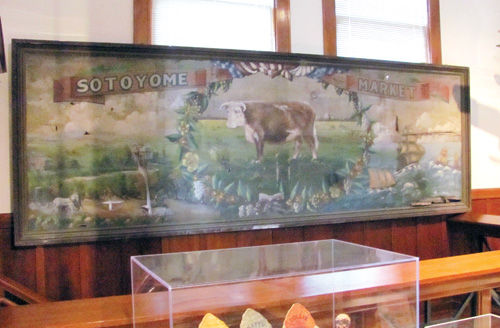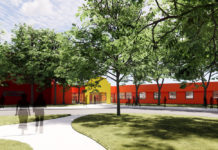
Plans to complete repairs in October
The Healdsburg Museum and Historical Society has moved forward with a project to conserve a damaged, 14-foot-wide painting dating back to 1878. With $6,000 in funding, the museum recently completed preliminary cleaning and repairs to the painting, which once hung in the Sotoyome Market butcher shop on the Healdsburg Plaza.
Niccolo Caldararo, a private practice art conservator who has previously worked with the Asian Art Museum and de Young Museum in San Francisco, is leading the conservation project and recently spent a week in Healdsburg meticulously cleaning the Sotoyome Market painting with cotton balls and swabs and repairing tears to the canvas.
The painting was created by local artist W.B. Monmonier for the Healdsburg Plaza butcher shop. Scenes depicted in the painting include a marine view and a harvest field, with a large steer dominating its center.
“It’s absolutely 100 percent local history,” museum curator Holly Hoods said of the painting. “The artist was a local painter who was kind of an entrepreneur in 1870s Healdsburg. He painted paintings, he also painted interiors of houses; he painted exteriors of houses… He wasn’t necessarily a fine artist, he was a vernacular artist.”
Before finding its way to the Healdsburg museum, the painting underwent an odyssey of sorts. For a time, it lay forgotten under the porch of the historic Camellia Inn, was later donated to the Healdsburg Museum and Historical Society and survived a rough encounter with a forklift while in storage. Before its most recent reunion with the museum, the painting resided for 17 years inside a local barn.
“Jim and Barbara Fagan, who lived in Dry Creek Valley, had this nice big barn and they offered to take the painting and store it,” explained Hoods. “That was back in 1994. It stayed at the Fagan’s barn until 2011. I started at the museum in 1996 and I never knew a thing about it.”
When the Fagan family reached out to the museum to remind them that they had the painting on hand, Hoods said she decided to move it back to the museum. “They sent me a picture, and it was pretty damaged,” she said. “And at that time, we went and reclaimed it and it was quite a production getting it off of the wall.”
After the painting returned to the museum in 2011, officials began to reach out to the community for donations to help clean and conserve it. “We sort of mounted a campaign to try to raise money, and a number of people contributed,” Hoods said.
When Caldararo began his conservation work on the Sotoyome Market painting, he came upon a few surprises, according to Hoods. “He found that on the backside, there was a lot of dirt and silt and that it appeared to have been in a flood. So that was a big surprise to him and us.”
After receiving an estimate from Caldararo, Hoods said the museum decided to fund initial repair work and later decide whether to pursue more extensive repair efforts.
Cleaning the painting revealed surprises, according to Hoods, including several bullet holes located in the steer’s head, as well as the distinct visage of John D. Hassett, the original market owner, hidden in a carriage in the painting.
Though his current work cleaning and repairing patches has served to conserve and stabilize the painting, Caldararo said he suggested two potential avenues for the museum to pursue if it wishes to conduct light restoration work, including inpainting that would tone patched areas to reflect surrounding colors, or more intensive restoration that would also add some design elements.
“We feel that it’s so close to being done, we want to go the rest of the way,” Hoods said, though she said the goal is not to return the painting to its 1878 state.
“We’re not trying to put in new paint to bring the painting exactly the way it was,” she said. “We’re not trying to repaint the painting. We’re trying to stabilize it. We’re trying to clean it so that it’s not compromised by the dirt… We’re willing to display in less than perfect condition, because that’s what it is.”
Hoods anticipates that Caldararo will return to Healdsburg in October to complete the remaining work, which may cost between $1,000 to $2,000, depending on the detail of the inpainting. “We’re very close to our fundraising goals, but just a little more would get us over the top,” Hoods said.
Those interested in contributing to the conservation of the Sotoyome Market painting may contact the Healdsburg Museum and Historical Society at 431-3325.









